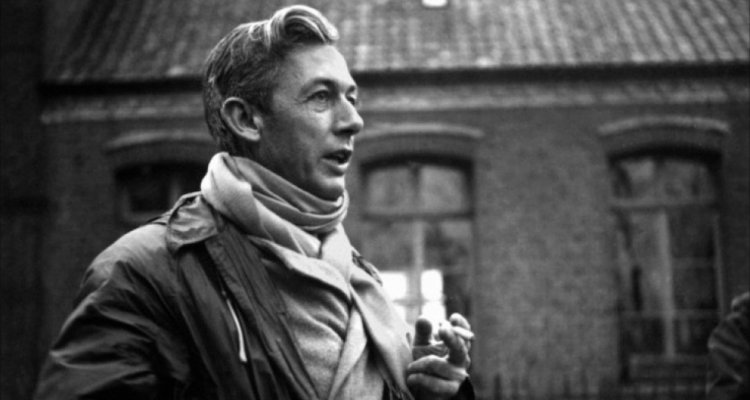“We are still coming to terms with Robert Bresson, and the peculiar power and beauty of his films,” Martin Scorsese said in the 2010 book “A Passion For Film,” describing the often overlooked French filmmaker as “one of the cinema’s greatest artists.”
But while he may be revered by some as the finest French filmmaker bar Jean Renoir, outside hardcore cinephile circles he and his films are virtually unknown (perhaps regarded as too opaque or nebulous). Just consider the fact that almost every definitive book on the elusive director was published during the aughts to feel the full truth of Scorsese’s statement about how we’re still in the process of appreciating and understanding his life and work. Even Bresson’s actual birthdate is contested, adding further the ambiguities surrounding the director.
“Make visible what, without you, might perhaps never have been seen,” the meticulous Bresson once famously said, hinting at what might have been his raison d’etre: to transcend the trappings and conventions of the moving image and distill all things down to their essence of all things. This unending, almost religious, quest for a type of cinematic divinity — the desire to go beyond the corporeal — coupled with Bresson’s Catholicism has compelled many a critic to describe him as a spiritual filmmaker or even, more categorically, a flat-out religious one. And while there is, as Scorsese puts it, a “peculiar power” to Bresson’s enigmatic art, an ineffable quality that does carry an elusive spiritual mien, to box Bresson in as a religious filmmaker is far too reductive. Author Kent Jones also rejected this notion, instead preferring to focus on what he described as “the sensual details” of Bresson’s art in his 2008 BFI book about the filmmaker.
Described as a “painter” of films and known for his formal austerity, economical rigor, contemplative distance and minimalist approach, Bresson is still one of the most counter-intuitive filmmakers ever, receding where others would pull in and abandoning powerful techniques of cinema, like the close-up and musical underscoring. Yet perversely, by employing pretty much the opposite of traditonal film grammar, he almost always achieved the peculiar effect of coercing the viewer to pay deeper attention.
This singularity of approach extended across all aspects of his productions: Bresson famously stopped using professional actors after his sophomore film and even began referring to his thespians as “models” instead of actors. “Films can only be made by by-passing the will of those who appear in them, using not what they do, but what they are,” he once said, again, speaking to his desire to strip all things down to a quintessence, a self, a soul. His was always an idiosyncratic and uncompromising vision.
Directing only thirteen films (and one missing short) over the course of 40 years, Bresson moved at a deliberate pace, but created a lasting and indelible body of work that is still being examined, debated and pored over. With no autobiography and a paucity of interviews available — at least compared to the average auteur — the filmmaker has attained an even deeper mystique, compelling viewers to project their own emotional and psychological interpretations onto his spare images. Perhaps that was the point all along: the ascetic, objective and sparse nature of his work creates a wide canvas that invites and envelopes the careful viewer, and leaves us enraptured.
But whatever the individual responses, Bresson’s stark poetic meditations on suffering, salvation, alienation and the human condition are profound, striking works that operate on a plane few filmmakers can touch. Following a revival at Film Forum earlier in the year, we thought BAM Cinematek’s currently running retrospective of the filmmaker’s work was an opportune moment to explore and examine this undersung titan’s oeuvre. And so, below we start with his early, almost conventional works, move on to his second-phase spartan portraits of human misery and suffering, and take you right through to the third act of his career, comprising unsentimental social critiques, often based on the books of Dostoevsky. We hope it inspires some of you to seek out his work.
 “Les Anges du Péché” (1943)
“Les Anges du Péché” (1943)
Made in 1943 during the Nazi occupation of France, nine years after his short, “Les Affaires Publiques,” (which was a comedy, no less), “Les Anges du Péché” was Bresson’s first full-length feature film. A collaboration with playwright Jean Giraudoux and Dominican priest and writer, Father Bruckberger, the story follows a well-to-do young woman Anne-Marie (Renée Faure) who decides to join a convent, where the nuns work at rehabilitating female prisoners (the convent had a real-life model). At the prison she meets Thérèse (Jany Holt), who refuses the nuns’ help, as she maintains she is innocent of the crime of which she was convicted. After she is released from prison, Thérèse gets revenge on her former lover, the man who framed her, and hides out afterwards in the convent, much to the delight of Anne-Marie, who believes she is seeking salvation rather than simply hiding out from the police. It’s something of a spiritual thriller, with the two female leads both seeking redemption from two different perspectives, that of sinner and would-be saint. However, in the end, they find their redemption in each other, though Bresson refuses absolutes, and finds neither woman wholly good nor entirely evil. Unlike most of his films, here the cast are professional actors, and the two leads shine, particularly Jany Holt. It is regarded as the director’s most “conventional” feature in terms of acting, music (his only film featuring an original score), dialogue and plot, but the spiritual subject matter and the relative sparsity of the filming style foreshadow Bresson’s future films. [B]

